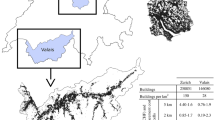Abstract
Tier 2 (preliminary) evaluation methods seem to be efficient in determining seismic vulnerability of buildings in large building stocks because they can be used to determine the seismic performance of a single building when compared to Tier 1 evaluation methods (street survey). Besides, they require less time as opposed to detailed evaluation methods (Tier 3). Eleven preliminary vulnerability analysis procedures are compared considering the data of 192 buildings experienced either 2011 Van Earthquakes, 2003 Bingöl Earthquake or 2002 Afyon Earthquake. Comparisons are made in terms of the number of parameters, influence of parameters on final seismic score, weighing factors of the parameters, the success rate of predicting the seismic performance of the examined buildings. Investigated procedures use at least four parameters and at most 22 parameters. Although number of stories have adverse effect on the seismic performance, concrete strength, area of shear walls and columns seem to have positive effect. Among the main parameters used in all procedures, area of shear walls is found to be the most influential parameter; however, concrete strength is one of the least effective parameters. As for the rate of correct vulnerability estimate of the 192 buildings, it is found that the best prediction rate belongs to Sucuoglu and Yazgan (in Wasti and Ozcebe (eds) Seismic assessment and rehabilitation of existing buildings, NATO science series (series IV: earth and environmental sciences), Kluwer Academic Publishers, London, 2003) with 79.2%. All the procedures except Ozcebe et al. (in Wasti and Ozcebe (eds) Seismic assessment and rehabilitation of existing buildings, NATO science series (series IV: earth and environmental sciences), Kluwer Academic Publishers, London, 2003) have correct estimate rate equal to or higher than 63%.















Similar content being viewed by others
References
American Society of Civil Engineers (ASCE) (2017) Seismic evaluation and retrofit of existing buildings (ASCE/SEI 41-17) Reston, VA
American Society of Civil Engineers (FEMA 310) (1998) Handbook for the seismic evaluation of buildings-a prestandard. Prepared for the Federal Emergency Management Agency, Washington, D.C.
Bayraktar A, Altunisik AC, Türker T, Karadeniz H, Erdogdu S, Angin Z, Özsahin TS (2015) Structural performance evaluation of 90 RC buildings collapsed during the 2011 Van, Turkey, earthquakes. J Perform Constr Facil 29(6):04014177
Boduroğlu H, Çağlayan PÖ (2007) Mevcut yapıların değerlendirmesinde bir tarama yöntemi. In: Sixth national conference on earthquake engineering, Istanbul, Turkey, 16–20 October (in Turkish)
Boduroglu H, Ozdemir P, Ilki A, Sirin S, Demir C, Baysan F (2004) Towards a modified rapid screening method for existing medium rise RC buildings in Turkey. In: 13th world conference on earthquake engineering, vol. 13
Erdil B (2017) Why RC buildings failed in the 2011 Van, Turkey, earthquakes: construction versus design practices. J Perform Constr Facil 31(3):04016110
Hassan AF, Sozen MA (1997) Seismic vulnerability assessment of low-rise buildings in regions with infrequent earthquakes. ACI Struct J 94(1):31–39
Ilki A, Comert M, Demir C, Orakcal K, Ulugtekin D, Tapan M, Kumbasar N (2014) Performance based rapid seismic assessment method (PERA) for reinforced concrete frame buildings. Adv Struct Eng 17(3):439–459
JBDPA (2001) Standard for seismic evaluation of existing reinforced concrete buildings (Version 2001). The Japan Building Disaster Prevention Association, Tokyo, Japan
Kandilli Observatory and Earthquake Research Institute (KOERI 2017) http://www.koeri.boun.edu.tr/sismo/Personel/comoglu/depremnedir/index.htm. Accessed 20 Oct 2017
Kaplan O, Guney Y, Topcu A, Ozcelikors Y (2018) A rapid seismic safety assessment method for mid-rise reinforced concrete buildings. Bull Earthq Eng 16(2):889–915
Otani S (2000) Seismic vulnerability assessment methods for buildings in Japan. Earthq Eng Eng Seismol 2(2):47–56
Ozcebe G, Yucemen MS, Aydogan V, Yakut A (2003) Preliminary seismic vulnerability assessment of existing reinforced concrete buildings in Turkey. In: Wasti ST, Ozcebe G (eds) Seismic assessment and rehabilitation of existing buildings, NATO science series (series IV: earth and environmental sciences), vol 29. Kluwer Academic Publishers, London
Özel G, Solmaz A (2012) Türkiye’de deprem tekrarlanma zamanının tahmini ve neotektonik bölgelere göre depremselliğin Markov Zinciri ile incelenmesi. Çankaya Univ J Sci Eng 9(2):125–138 (In Turkish)
Structural Engineering Research Unit (2017) Archival material from Afyon and Bingöl Earthquake database. Middle East Technical University, Ankara, Turkey. http://www.seru.metu.edu.tr/archives.html. Accessed 23 Oct 2017
Sucuoglu H, Yazgan U (2003) Simple survey procedures for seismic risk assessment in urban building stocks. In: Wasti ST, Ozcebe G (eds) Seismic assessment and rehabilitation of existing buildings, NATO science series (series IV: earth and environmental sciences), vol 29. Kluwer Academic Publishers, London, pp 97–118
Sucuoğlu H, Yakut A, Özmen A, Kubin J (2015) Seismic risk prioritization and retrofit cost evaluation of code-deficient RC public buildings in Turkey. Earthq Spectra 31(1):601–614
Temur R (2006) Hızlı durum tespit (DURTES) yöntemi ve bilgisayar programının geliştirilmesi. Master’s thesis, İstanbul University, İstanbul, Turkey (In Turkish)
TERC1968 (Turkish Earthquake Resistant Code) (1968) Specification for structures to be built in disaster areas. Turkish Ministry of PublicWorks and Settlement, Ankara
TERC1975 (Turkish Earthquake Resistant Code) (1975) Specification for structures to be built in disaster areas. Turkish Ministry of PublicWorks and Settlement, Ankara
TERC1997 (Turkish Earthquake Resistant Code) (1997) Specification for structures to be built in disaster areas. Turkish Ministry of Public Works and Settlement, Ankara
TERC2007 (Turkish Earthquake Resistant Code) (2007) Specification for buildings to be built in seismic zones. Turkish Ministry of Public Works and Settlement, Ankara
Tezcan SS, Bal IE, Gulay FG (2011) P25 scoring method for the collapse vulnerability assessment of RC buildings. J Chin Inst Eng 34(6):769–781
Yakut A (2004) Preliminary seismic assessment procedure for existing RC buildings. Eng Struct 26(10):1447–1461
Yakut (2014) Examination of seismic performance assessment procedures for RC buildıngs in Turkey. In: Tenth U.S. national conference on earthquake engineering, Earthquake Engineering Research Institute, Anchorage, AK, USA, 21–25 July
Author information
Authors and Affiliations
Corresponding author
Rights and permissions
About this article
Cite this article
Erdil, B., Ceylan, H. A Detailed Comparison of Preliminary Seismic Vulnerability Assessment Methods for RC Buildings. Iran J Sci Technol Trans Civ Eng 43, 711–725 (2019). https://doi.org/10.1007/s40996-019-00234-6
Received:
Accepted:
Published:
Issue Date:
DOI: https://doi.org/10.1007/s40996-019-00234-6




